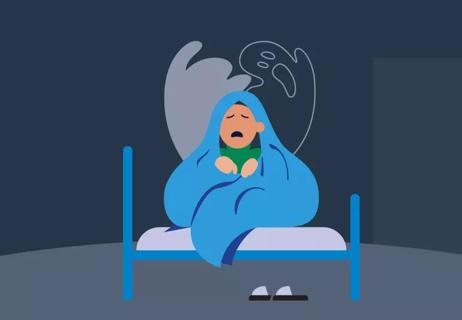Understanding one of sleep's big mysteries

Dreams have always been a somewhat mysterious part of our lives. Brain-driven hallucinations can feel real no matter how fantastical and can generate a range of emotions from sadness to fear. And things go to another level with the concept of lucid dreaming.
Advertisement
Cleveland Clinic is a non-profit academic medical center. Advertising on our site helps support our mission. We do not endorse non-Cleveland Clinic products or services. Policy
The idea of lucid dreaming involves the realization within the dream that it’s, well, a dream and not reality and, for some people, the ability to change the “plot” of your dream as it unfolds.
But how much of this is true and how much of it is, like dreams themselves, a creation of our brains? We talked to sleep disorder specialist Alicia Roth, PhD, about lucid dreams and the reality of what’s going on when you realize you’re dreaming.
“The basic definition of lucid dreaming is that while you’re in the dream, you become aware of the fact you’re dreaming,” says Dr. Roth. Various studies estimate around half of the world’s population experiences lucid dreaming.
There’s much less known about people who claim to have the ability to control or manipulate their dreams. “The research on lucid dreaming relies mostly on the self-report of the person dreaming. There are few objective ways to measure lucid dreams,” Dr. Roth adds.
“Whether it’s lucid dreams, regular dreams or nightmares, it’s a very difficult thing to measure objectively,” she continues. “There are ways that we can tell when people are in REM sleep. If they’re observed with a polysomnogram or an MRI scanner, we can see brain changes. But we can’t even precisely tell when people are actually dreaming.”
Advertisement
Again, the data is lacking and figuring out exactly how lucid dreams occur is tricky, notes Dr. Roth. But they occur mostly during REM sleep. “REM sleep is when your most vivid dreams occur,” says Dr. Roth, “and it’s a very active time for your brain. If you did a sleep study, your brain during REM sleep looks a lot like it does activity-wise when you’re awake.”
It’s possible sleep disruptions or disorders, particularly affecting REM sleep, affect the frequency of lucid dreams.
One study found patients with narcolepsy had a higher frequency of lucid dreams than the study’s control patients. Another report suggested that “a shift in brain activity in the direction of waking” during REM sleep dreaming causes the move towards lucid dreaming, creating a “hybrid” situation involving “features of both REM sleep and waking.”
But, for now, the actual cause of lucid dreams and even why some people have them and others don’t remain unsolved.
It’s hard to know really how effective specific techniques can be given the unreliable self-reporting nature of data that Dr. Roth noted. But studies have focused on a handful of specific methods that participants suggest work. Just take it all with a grain of salt.
The process of reality testing involves constantly testing the “reality” of your surrounding throughout your waking day. Some examples include looking at your reflection in the mirror, pushing against solid objects or even trying to breathe through a pinched nose. The idea is that if you do this enough while awake, you’ll do them in your dreams, too, and when you notice that these tests go differently in your dream state, you’ll become aware that you’re dreaming.
The MILD approach involves leveraging your intention to remember to do something in the future; in this case, remembering your dreaming. This usually involves waking up after sleeping for several hours, recalling your most recent dream, and reciting a version of the command “the next time I’m dreaming, I’ll recognize I’m dreaming.”
Typically combined with the MILD approach, this technique involves sleep disruption. After sleeping for a while, a person will intentionally wake themselves via an alarm, stay awake for a set amount of time, and then go back to sleep.
Other approaches involve devices delivering external stimuli to a person in REM sleep. Whether flashing lights, tones or even smells, the aim is to see if those stimuli were incorporated into the sleeper’s dream and whether or not they could trigger lucid dreaming.
Advertisement
As with other aspects of lucid dream studies, there’s a limited amount of data available to confirm how beneficial lucid dreams are.
At least two studies, including one involving throwing darts, looked at whether or not lucid dreams can help motor skills. Both found data that suggests that lucid dreams can improve performance.
Two more studies suggest that people who have lucid dreams may be more creative.
While these findings are preliminary and more research is needed before any concrete assertion can be made, Dr. Roth points out there is at least one benefit of lucid dreams that’s been empirically proven.
“One theory is that REM sleep is your brain organizing your life or your day in its own way, kind of like cleaning up a messy work desk,” Dr. Roth says. “Your brain decides what’s important to remember and what’s not important. And dreaming is the process of your brain organizing and placing things.”
Nightmares, Dr. Roth notes, occur when your brain is trying to organize things in a detrimental way. And one way to help you break that pattern is a treatment called imagery rehearsal therapy.
“We start with training the patient to do pleasant guided imagery while they’re awake. We teach them how to incorporate all five senses, even focusing on creating a scene of something they enjoy doing,” Dr. Roth says. “Once you start doing this right before bedtime, it can sometimes work its way into your dreams.”
Advertisement
But the nighttime aspect focuses more on recognizing the anxious dream situation or nightmare when it’s happening. “People write out the narrative of the nightmare and then rescript it to end a different way,” Dr. Roth says. “We help you identify the hotspot of the dream, the point at which the dream goes wrong, and rescript the narrative from there.”
The patient will then rehearse the dream, rereading the narrative and visualizing it. Some patients, she says, even choose to make their own movies of the rescripted version with their smartphone. “When they’re rehearsing these rescripted dreams, they’re able to get their brain to organize them in a way that’s beneficial,” she says.
When the patient reaches the hotspot in the dream, they’re able to recognize the situation as a dream or follow the rescripted path.
Again, with the lack of concrete data, it is hard to know if lucid dreams are really “harmful” to a person. But for people interrupting their sleep pattern to induce lucid dreaming, that can lead to sleep deprivation which can affect alertness, memory, stress and even lead to issues like high blood pressure and diabetes.
Advertisement
Learn more about our editorial process.
Advertisement

The short answer from a sleep psychologist

A sleep expert weighs in

Nightmares in children are common and more likely when your child is overtired or stressed

Getting enough sleep and keeping the bedroom quiet and restful can help

Type 2 diabetes isn’t inevitable with these dietary changes

Applying a hot or cold compress can help with pain